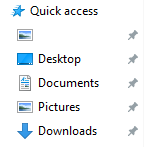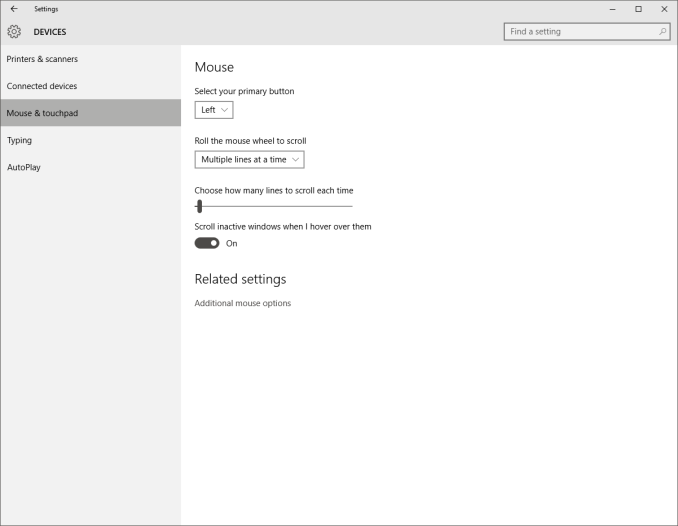The Windows 10 Review: The Old & New Face of Windows
by Brett Howse on August 25, 2015 8:00 AM EST- Posted in
- Operating Systems
- Microsoft
- Windows 10
More Desktop Changes
One of the goals of Windows 10 is to entice Windows 7 users to migrate to the new operating system. The additions we’ve seen already to the traditional mouse and keyboard interface have already been substantial, and should make most Windows 7 users comfortable. But they are not the only changes to the desktop. There is a little bit for everyone, both casual users and enthusiasts alike, so lets check out some more of the new features of Windows 10’s desktop.
Windows 8 changed up Windows Explorer, and brought in the ribbon menu. Office 2007 was the first Microsoft program to move from the file menu to the ribbon menu, and while it was controversial at the time, it is now very familiar. Moving Windows Explorer to a ribbon menu made it both easier to use with touch, as well as exposing settings and features that may have been tucked away in a submenu before. Windows 10 evolves this. Opening up Windows Explorer now greets you with a list of files you have recently accessed in the main pane. The thinking is that when you go to Explorer, you are likely looking for something you’ve used before. I won’t dispute the logic, but I prefer to see the computer view myself. Luckily it’s an easy option to change by clicking File->Change folder and search options. What I do like though is the Quick Access feature in Windows Explorer, which gives you – you guessed it – quick access to folders that are used a lot. The system will automatically add folders you go to frequently which is kind of great for discoverability, and you can add or remove any folder here. I have found it very useful, and since it is also built into the file picker for saving files, it makes it easy to get where I want to go when saving files.
Another nice feature to come to Windows Explorer is the Share contract. Windows 8 introduced contracts, which allow apps to communicate with one another over dedicated protocols, and adding it to Windows Explorer is a great way to expand them from the tablet style apps to the desktop. Share was likely the most useful contract, and I was always disappointed that the Windows 8 Charms did not offer any functionality on the desktop, so this is a great addition.
There are also small changes which improve Windows 10 over Windows 8. Things like having drop shadows back. Windows 8 went for a very flat UI, and it was clean looking but the lack of depth was not very useful with multiple windows open. Adding drop shadows back give the subtle definition around windows to make them stand out a bit more.
One of my favorite features that has come to Windows 10 is the ability to scroll an inactive window. Prior to Windows 10, and assuming you were not running a third party utility which enabled this, in order to scroll a window you had to first select it. Now, you can just move your mouse over any open window and use the scroll wheel to move whatever window you are over. You can do this on windows that are buried three or four deep – as long as you can see some of it you can scroll it. It is great when you are referencing a PDF or site, and writing at the same time, since you can continue to type while scrolling around in your reference document. For those that think this is insane, yes, you can turn it off.
Windows 8 seemed to signal that Microsoft was looking to a future past the desktop. There were some nice changes brought to the Windows 8 desktop but they were overshadowed by the changes brought in by the touch-first UI. With Windows 10, Microsoft is not only trying to bring back the focus on the desktop, they have added a lot of great features as well which should certainly entice users of both Windows 7 and 8.1 to want to switch.














293 Comments
View All Comments
jeffkibuule - Tuesday, August 25, 2015 - link
Microsoft can never prove a negative, so there's nothing to say there.Tons of consumer protection laws protect against selling you X and then trying to charge Y for the same thing via an update.
Oxford Guy - Tuesday, August 25, 2015 - link
So discontinue "10" early and change the terms for the "10.1" or "11" "upgrade".chrome_slinky - Wednesday, August 26, 2015 - link
But according to Microshaft, this is Windows Last. All there is and there is no more, other than constant updates breaking things, until the hardware you own is no longer supported. You've EOL'd from Windows.boeush - Tuesday, August 25, 2015 - link
With respect to the new mandatory auto-update mechanism, I assume the system recovery feature and restore points are still around? If one could always rollback to some previous known-stable system configuration, then all MS would need to do (relative to Win 7 - don't know about Win 8) is automatically keep a large number of restore points spanning at least a couple of months - and add the ability to block a specific update from installing again in the future. Then on the rare occasion that MS screws the pooch by trashing a couple billion PCs worldwide, the process to fix them would be relatively painless for the end-users...Oxford Guy - Tuesday, August 25, 2015 - link
Who doesn't want huge amounts of I/O going toward that, as well as storage space and processing power?Or, they could just stop force-feeding people.
boeush - Wednesday, August 26, 2015 - link
Who said anything about 'huge'? In the same way as version control systems, they only need to store the change 'delta' - and they can compresstge hell put of that data as well (fast or frequent I/O on those files wouldn't be a priority.)boeush - Wednesday, August 26, 2015 - link
Damn phone keyboards and no edit function on posts..."...compress the hell out of..." - was what I *meant* to write.
vladx - Tuesday, August 25, 2015 - link
The OneDrive changes, Windows Update new restrictions will keep on Windows 8.1 until they offer the option to have the old ways back.dragonsqrrl - Tuesday, August 25, 2015 - link
I've been waiting patiently for this, thank you!takeship - Wednesday, August 26, 2015 - link
Is there are run down of the new/updated tablet features of windows 10, or did I miss that? Does Win10 make any/noticable changes or improvements for touch users?